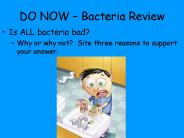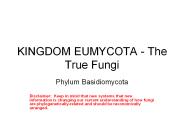Puffball PowerPoint PPT Presentations
All Time
Recommended
(columella) 'spongy potato' animal dispersed. Sclerodermataceae. hard ... columella. sterile tissue in gleba. peridium thick, separable. rubbery. fetid odor ...
| PowerPoint PPT presentation | free to view
Kingdom Fungi Puffball mushroom releasing spores Bread Mold Sporangia Slime Mold feeding on Bacteria Penicillin Mold Kingdom Fungi Puffball mushroom releasing spores ...
| PowerPoint PPT presentation | free to view
Fungi secrete powerful enzymes that digest food ... Basidiomycota-mushrooms, toadstools, puffballs. Sporangium is club-shaped (basidium) ... Poisonous toadstool ...
| PowerPoint PPT presentation | free to view
Panama Disease Fusarium wilt. Banana suckers' for propagation ... Oyster mushrooms (Pleurotus spp.) Hallucinogenic. Amanita spp. Edible. Poisonous. Puffballs ...
| PowerPoint PPT presentation | free to view
... (examples to follow) Examples Penicillium on an orange Bread mold Powerful Puffballs B-Structure: 1-Hyphae-have enzymes (to digest food); ...
| PowerPoint PPT presentation | free to view
Whistler. Chirpy. Fang. Buffy. Claws. Fluffy. Initial cursor position. next ... Whistler. Slim. Puffball. Basic Getter Methods. int getInt(int columnIndex) ...
| PowerPoint PPT presentation | free to view
Kingdom Fungi. Puffball mushroom releasing spores. Bread Mold Sporangia. Slime Mold feeding on Bacteria. Penicillin Mold ...
| PowerPoint PPT presentation | free to view
Mantle middle layer, a thick solid zone that surrounds the earth's core. ... Compost. Spores of mushrooms, puffballs, and truffles ...
| PowerPoint PPT presentation | free to view
Blue-green Algae: Monera. Dandelion: Plantae. Puffball: Fungi. Goldfish: Animalia. One-celled Algae: Protista. Sponge: Animalia ...
| PowerPoint PPT presentation | free to view
Fungi are adapted to absorb their food from the environment. ... called basidia. include mushrooms, puffballs, and. shelf fungi. 19.5 Diversity of Fungi ...
| PowerPoint PPT presentation | free to download
The JDBC API is the industry standard for database-independent connectivity ... Whistler. Slim. Puffball. Initial cursor position. next() next() ResultSet Object ...
| PowerPoint PPT presentation | free to view
Identified fungi (73 species) Agaricus campestris (Pink agaric) Agaricus spp. X1 ... (Bramble rust) Piptoporus betulinus (Birch polypore / Razor strop bracket fungus)
| PowerPoint PPT presentation | free to download
There I s Fungus Among Us An investigation into the many unique types of fungus. Four Main Groups Threadlike Fungi Sac Fungi Club Fungi Imperfect Fungi Parts of Fungi ...
| PowerPoint PPT presentation | free to download
Basidiomycete: hedgehog mushrooms Hydnum. Basidiomycete: stinkhorn. Dictyophora duplicatal ... (killing kind) Marasmius oreades. Oyster mushrooms. Pleurotus ...
| PowerPoint PPT presentation | free to view
Title: Lecture #13 Date _____ Author: Chris Hilvert Created Date: 11/29/2000 2:39:34 PM Document presentation format: On-screen Show Company
| PowerPoint PPT presentation | free to view
Kingdom FUNGI Kingdom FUNGI Some are unicellular, but many are colonial lack chlorophyll - can't make own food grouped into three phyla: Kingdom FUNGI Phylum ...
| PowerPoint PPT presentation | free to download
Title: The FUNGUS Kingdom Author: Maureen B. Moroney Created Date: 3/7/2004 5:23:34 PM Document presentation format: On-screen Show Company: MBM Other titles
| PowerPoint PPT presentation | free to download
What are Living Things Like Notes Objective Distinguish between living things and nonliving things. Vocabulary Organism Cell Homeostasis Organism Any living thing.
| PowerPoint PPT presentation | free to view
... Fungi come in many shapes and sizes. Sac fungi form a reproductive sac, or ascus. Yeasts = single-celled sac fungi. Morels and truffles = multicellular sac fungi.
| PowerPoint PPT presentation | free to download
KINGDOM EUMYCOTA - The True Fungi Phylum Basidiomycota Disclaimer: Keep in mind that new systems that new information is changing our current understanding of how ...
| PowerPoint PPT presentation | free to download
Basidiospores that are formed symmetrically on sterigmata and are not ... Funicular cord. Peridioles. Crucibulum. Photo by Guillermo Pimentel. Sphaerobolus ...
| PowerPoint PPT presentation | free to view
... (lignin!), also form mycorrhiza Most vascular plants are associated with mycorrhizae. Photo: ectomycorrhizal fungi (Hebeloma and Lactarius species) ...
| PowerPoint PPT presentation | free to view
Super Mario. Mario is a plumber who always has to save princess Peach from Bowser. Mario: Today. Mario: Back in the day. Metroid ...
| PowerPoint PPT presentation | free to view
Six Kingdoms Fungi Zombie Fungus Important Characteristics Eukaryotes (have a nucleus) Mostly multicellular (unicellular = yeasts) Use spores to reproduce ...
| PowerPoint PPT presentation | free to view
Sexual Reproduction Ch 38.1 Guide Ch 38.2 Development I1.Sexual/Asexual Reproduction Asexual Exact copy Mitosis One parent Constant conditions Sexual Genetic variety ...
| PowerPoint PPT presentation | free to view
The Kingdom Fungi Mysterious Molds Mildews And Mushrooms Fungi are their own kingdom Fungi are not plants Plants make their own food (sugars) from light Fungi are ...
| PowerPoint PPT presentation | free to view
Chytridiomycota, Allomyces hyphae with gametangia ... Fruticose lichen. Foliose lichen. Lichen soredia. Lichen producing soredia along margin of thallus ...
| PowerPoint PPT presentation | free to view
The Kingdom Fungi Chapter 21 Structure and Function of Fungi Structure and Function Multicellular (except yeasts) Composed of hyphae thin filaments one cell thick ...
| PowerPoint PPT presentation | free to download
18-3 Two Modern Systems of Classification kingdom cell type no. of cells nutrition Archaebacteria pro. uni. both
| PowerPoint PPT presentation | free to download
IV. Fungi KNOW RED STUFF A. Overview 1. General Characteristics - multicellular eukaryotes - heterotrophic - absorptive nutrition: excrete enzymes into environment ...
| PowerPoint PPT presentation | free to download
FUNGI Wow! Fungi plant growth - The Private Life of Plants - David Attenborough - BBC wildlife - YouTube Fungi Structure & Function hyphae: chitin mycelium fruiting ...
| PowerPoint PPT presentation | free to view
Basidiomycota taxonomy Hymenomycetes
| PowerPoint PPT presentation | free to view
Title: No Slide Title Author: Melissa Marcum Last modified by: mmarcum Created Date: 9/23/2000 10:06:12 PM Document presentation format: On-screen Show (4:3)
| PowerPoint PPT presentation | free to download
Title: Wednesday, September 5 Author: Peter Last modified by: Peter Created Date: 8/16/2006 12:00:00 AM Document presentation format: On-screen Show (4:3)
| PowerPoint PPT presentation | free to download
Fungus Characteristics -eukaryotic cells - multicellular / unicellular (yeast) - heterotrophs : many are decomposers Structures - hyphae : basic unit of multicellular ...
| PowerPoint PPT presentation | free to view
Sexual Reproduction Ch 38.1 Guide Ch 38.2 Development I1.Sexual/Asexual Reproduction Asexual Exact copy Mitosis One parent Constant conditions Sexual Genetic variety ...
| PowerPoint PPT presentation | free to view
Chapter 31 Chapter 31 ~ Fungi Fungi 1)Eukaryotic 2)Heterotrophic by absorption (exoenzymes) What does this mean? Decomposers /(saprobes), parasites (predators ...
| PowerPoint PPT presentation | free to download
... Rhizopus (black bread mold) Asexual with sporangia Sexual with zygospores Phylum examples types of reproduction Ascomycota (cup fungus) ...
| PowerPoint PPT presentation | free to download
Leaves can be eaten raw in salads, steamed, or sauteed. ... include using the leaves to make dolls, thatching for roofs, baskets and mats. ...
| PowerPoint PPT presentation | free to view
Hyphae: body filaments septate (cross walls) coenocytic (no cross walls) ... Septate hypha. Septum. Pore. Cell wall. Cell wall. Nuclei. Coenocytic hypha. LE 31-2 ...
| PowerPoint PPT presentation | free to view
The Fungi Kingdom Mycology - the study of fungi fungi - plural fungus - singular 4 Main Characteristics of Fungi 1) fungi are eukaryotic they have a nuclei & mitochondria
| PowerPoint PPT presentation | free to download
PowerPoint Presentation
| PowerPoint PPT presentation | free to view
FUNGI An Overview Characteristics of Fungi Eukaryotic Nonphotosynthetic ( heterotrophic) Most are multicellular Most are microscopic molds or yeasts The study fungi ...
| PowerPoint PPT presentation | free to view
Five Kingdom Classification System
| PowerPoint PPT presentation | free to download
* * * * * * * * * * * * * * Cross Walls of Hyphae coenocytic having multiple nuclei embedded in cytoplasm without cross ...
| PowerPoint PPT presentation | free to download
An example of Fungi You know Zygomycota common molds Ascomycota Cup Fungi Life Cycle Yeast is an Ascomycete Fungus Morels are Ascomycete Fungi Basidiomycete ...
| PowerPoint PPT presentation | free to download
Basidiomycetes basidiospores sterigmata Basidium * * * * * * * * * * * Uredospores of Bean rust Uromyces appendiculatus Uromyces appendiculatus uredospore germinating ...
| PowerPoint PPT presentation | free to view
Asexual: hyphae break off from a fungus & begin to grow on ... Examples include: blue cheese (Penicillium mold) and Aspergillus (soy sauce) Lichens/Mycorrizae ...
| PowerPoint PPT presentation | free to view
II Modern Taxonomy A. Evidence Used in Classification Comparative morphology (Similarities in ... Embryology (wings of a birds & insect, different ...
| PowerPoint PPT presentation | free to download
... Produces the antibiotic penicillin Deuteromycetes can cause skin diseases such as athlete s foot Fungi Plants ... fungal crop diseases ... disease in humans ...
| PowerPoint PPT presentation | free to view
Fungi: General Structures. A typical mushroom is just a small portion of the ... 3. Within the fruiting body the 2 nuclei may fuse to form a diploid zygote. ...
| PowerPoint PPT presentation | free to view
Fungi are more like animals than like plants. Fungi ... Stipe. Hymenium (gills, pores, teeth, smooth) We use these features to ID mushrooms ...
| PowerPoint PPT presentation | free to view
Kingdom Fungi Video 1, Video 2 Biology 11
| PowerPoint PPT presentation | free to view
... (lignin!), also form mycorrhiza Most vascular plants are associated with mycorrhizae. Photo: ectomycorrhizal fungi (Hebeloma and Lactarius species) ...
| PowerPoint PPT presentation | free to view
Protists, Fungus and Plants Kingdom Protista All Eukaryotic (Have a nucleus) Most are Unicellular, some multicellular Classified based on MOVEMENT Either Autotrophs ...
| PowerPoint PPT presentation | free to download
This is the phylum that includes mushrooms. ... can tell the difference between poisonous and non-poisonous mushrooms ... We can eat some types of mushrooms. ...
| PowerPoint PPT presentation | free to view
























































